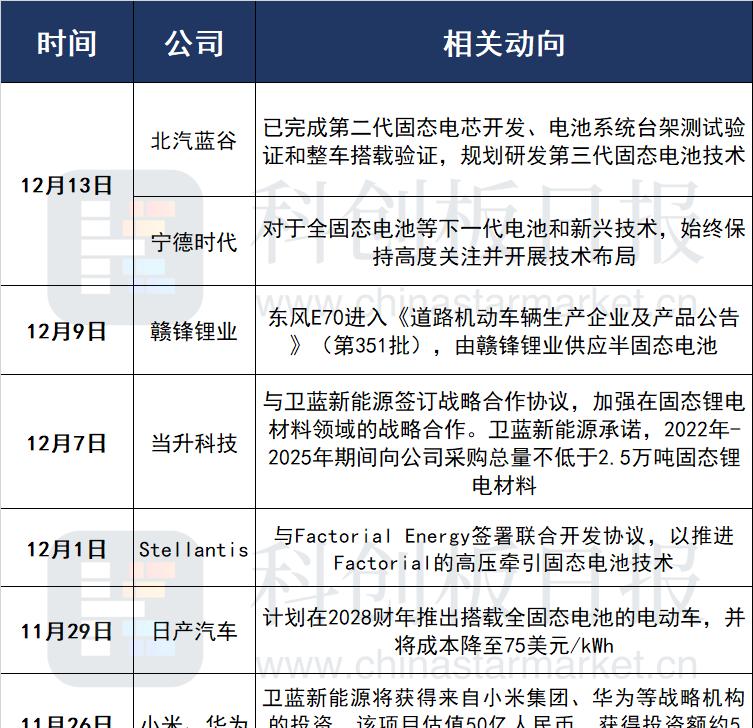"Science and Technology Innovation Board Daily" (editor Zheng Yuanfang), with the end of the year approaching, in the past half a month, when sheng technology, Ganfeng lithium and other companies outflow of solid-state battery new trends, the frequency of news has increased significantly compared with before.

For example, today, Beiqi Blue Valley revealed on the interactive platform that the company has completed the development of the second generation of solid-state batteries, the test and verification of the battery system bench and the verification of the vehicle (ARCFOXαT). Third-generation solid-state battery technology is also being planned.
Just last Friday, the Ministry of Industry and Information Technology announced the "Announcement of Road Motor Vehicle Manufacturers and Products" (Batch 351). It is worth noting that compared with the previous batch, the semi-solid-state battery (mixed solid-liquid electrolyte lithium battery) debuted - Dongfeng E70 is equipped with a semi-solid-state battery supplied by Ganfeng Lithium, and it is expected that the model will be delivered before the Spring Festival.
In addition, next year's new model ET7 will also be equipped with a semi-solid-state battery pack, and 2022 is also regarded as the "first year of the (semi-) solid-state battery on the car".
Why can a solid-state battery become the next choice to "lead countless heroes to bend their waists"?
At present, the two mainstream routes in the industry are lithium iron phosphate and ternary batteries, but neither of them can escape the two problems of safety and mileage.
On the one hand, the safety performance of liquid batteries has always been a major focus of industry attention, acupuncture tests have become almost every battery new technology conference "reserved program", and its liquid electrolyte is also regarded as the culprit behind the fire spontaneous combustion accident.
On the other hand, the Ministry of Industry and Information Technology "Made in China 2025" proposed that by 2025/2030, the energy density of China's power battery cells needs to reach 400Wh/kg and 500Wh/kg respectively. However, even liquid batteries that use a silicon-based anode to greatly increase their energy density are difficult to overcome the "hurdle" of 500Wh/kg.
In the face of these two problems, solid-state batteries are the most recent path at present.
It has advantages in energy density, output current stability, service life, volume, etc., and the most prominent advantages are safety and mileage: solid electrolyte is non-flammable, high temperature resistance, non-corrosion, non-volatile; in addition, the data shows that its endurance time can reach 2-3 times that of traditional liquid lithium batteries.
However, from the perspective of the research and development process of mainstream car companies such as Volkswagen and BMW, most of the mass production applications of solid-state batteries will not be realized until 2025 or later. Sugano, a distinguished professor at Tokyo Institute of Technology in Japan, said on Friday that the possibility of all-solid-state batteries being practical within 5 years is high.
In other words, in the short term, all-solid-state batteries still cannot be mass-produced.
Therefore, the "semi-solid-state battery" equipped with NIO ET7 and Dongfeng E70 partially reduces the amount of electrolyte and uses part of the solid electrolyte, thus acting as a compromise solution and becoming a "small goal" that can be completed first before moving towards the technology of all-solid state.
However, even if mass production is achieved, the future of solid-state batteries is still "a long way to go".
Leaving aside the sharp reduction in power density of solid-state batteries after leaving the laboratory; the expansion of electrodes in charge-discharge cycles, and the problem of poor fast charging performance, most consumers will also shake their heads.
Ouyang Minggao, academician of the Chinese Academy of Sciences, professor of Tsinghua University, and director of the State Key Laboratory of Automotive Safety and Energy Conservation, estimates that it will take about a decade for all-solid-state batteries to be industrialized and have an important impact on the market pattern. The existing lithium battery technology, including liquid batteries and semi-solid-state batteries, will still occupy an absolute dominant position until 2030.